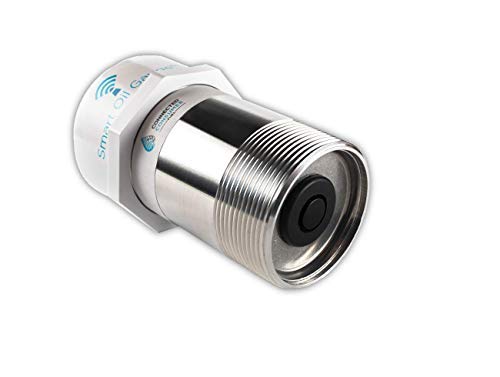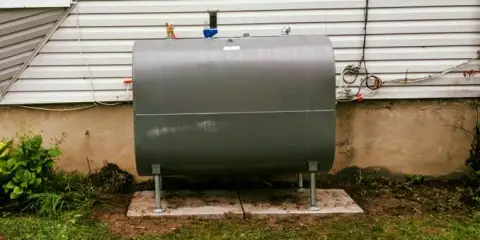Nothing worse than waking up in the middle of a cold wintry night with no heat coming out of the radiators. You suspect water got in your Oil Tank again a typical problem with older systems. How do you Test, Resolve and Prevent water from getting into your Oil Tank?
- To Test: Oil Tank-use a dipstick & Water Indicator Paste
- To Resolve: Use Alcohol-Based Dispersant or Kerosene to dissolve H2O Use a Water Absorbent Sock or Pump the tank Out
- To Prevent: Paint the above-ground outdoor oil tank silver or aluminum to reflect sunlight Keep your tank filled Monitor or Enclose the tank
Water in your Oil Tank and heating system can be costly and time-consuming. Water in your Oil Tank ends up in your Oil Burner and can destroy it creating a sludge that accumulates over time in your Tank that has to be pumped out.
How To Test and Remove Water In Your Oil Tank
With an above or grown Oil Tank, all you need is a long stick and a Water indicator paste-like Kolor Kut 3 Ounce Water Finding Paste The water settles to the bottom, and the oil floats on top. The Indicator Paste is used to locate where the water level is in the tank.
The Mustard yellow paste will turn red upon contact with water. You will get a great idea of if there is water and how much water is in the tank by this simple method. Now you know if and how much water is in your Oil Tank you’ll need to take it out. But How? If you have an above-ground metal oil tank, check for a sludge valve on the bottom of the tank.
You can drain water out by opening this valve. You may not get every dropout this way, but it’s at least a good place to start. Water that drains out will contain some oil as well, so you must be careful with how you collect and dispose of it Absorb It: For smaller amounts of water, you can take advantage of substances that naturally absorb water to extract it from your oil tank.
There are a couple of different ways you can do this. Alcohol-Based Dispersant: One way you can absorb water is with a water dispersant additive. These oil tank additives are typically alcohol-based and naturally absorb water. To use it, you simply pour the additive into your fill pipe of the tank and let it go to work. Some additives are not only designed to absorb water but to break down the oil tank sludge as well.
Anything you put into your Oil Tank will eventually end up in the heater filter and pump. Water-Absorbent Sock: Another way you can soak up water is by inserting an absorbent material into your tank for a prescribed amount of time and then removing it. These devices differ somewhat in shape and size, but they are typically made of cloth and are chemically treated to be extra-absorbent.
Some water-absorbent socks are capable of soaking up around two cups of water. If you have more water than that, but not so much that you should be pumping it out instead, you may need to purchase more than one sock or find one that is reusable. If you sucked the bottom of your oil tank there were a few tricks to get your system cleaned up and ready to go.
One method was to run to the gas station and pick up 5 gallons of Kerosene. Not only will your Oil Burner run on Kerosene but Kerosene in your Oil Tank would dissolve sludge, thin and clean the oil through the filter pump and nozzle in the firebox and the lines on the Burner System.
It was a secret weapon when it came down to running your oil tank too low and sucking up the mess that was at the bottom along with the water that was in there too. That led to trying to find a serviceman in the middle of the night.
https://youtu.be/O9WCHJsvAUE
How to Prevent Water From Entering Your Oil Tank
Once your tank has been cleaned of water and sludge it will need to be serviced again unless you can perform some easy maintenance on it to prevent it from happening again. Here are a few tips you can use: Paint the above-ground outdoor oil storage tank silver (aluminum paint) to reflect sunlight (and heat), or locate the tank in a shaded area if possible.
If you consider that in freezing climates it is sometimes recommended to construct a heated enclosure around an outside oil storage tank to avoid oil tank waxing or water freezing and loss of heat, that step will also reduce the problem of oil tank water accumulation due to condensation. Empty the Oil Tank with a heavy-duty pump that will clean out the sludge and sediment that has been collecting on the bottom of the tank for a while this Fill-Rite FR112 Rotary Vane Hand Pump with Discharge Hose, Nozzle Spout, and Suction Pipe
- 10 gallons per 100 revolutions
- Cast aluminum construction for corrosion resistance and lightweight
- The pump can be padlocked for security
- The pump can be set up for reverse flow
- Top-selling hand pump since the 1960’s – highly durable & easy to use
Absorb Water From Your Tank: Another way you can be sure to stay on top of any water issues is by keeping a water-absorbent sock in your tank at all times. Check with recommendations from manufacturers to see how long you can leave it in the tank, but likely can be left for a few months before needing to be changed. When you take it out, you can tell by looking at the sock whether it soaked up water, so this can also serve as an ongoing test.
These Socks are available through Amazon New Pig Sump Skimmer, Pull Oil Out of Sumps, Tanks and Bilges, Repels Water, 1-Gallon Absorbency, 8″ Dia x 18″, (12 Socks), SKM403 Keep Your Tank Filled: Leaving your outdoor oil tank invites condensation to occur inside the tank. This is especially true when outdoor temperatures are fluctuating and the air is humid.
For this reason, you should not let your tank sit under-filled for long periods of time. Measure your tank levels. Oil Tank Gauges are available like Smart Oil Gauge – Wi-Fi Heating Oil Tank Gauge – Check Your Oil Level From Your Phone, Compatible with Alexa Check your Oil Tank levels with your smartphone never have to worry about the levels in your tank that may have sludge at a certain level. Not like the old days.
- REMOTE OIL TANK MONITORING: Check your heating oil tank from your smartphone – anytime, anywhere! Don’t worry about running to the basement to check your tank.

 Check your tank from work, vacation, or wherever you have internet access. Got a second home or a rental property? Monitor the tanks from your phone and enjoy the peace of mind of knowing there’s oil in the tank.
Check your tank from work, vacation, or wherever you have internet access. Got a second home or a rental property? Monitor the tanks from your phone and enjoy the peace of mind of knowing there’s oil in the tank.
- LOW-LEVEL ALERTS: No more middle-of-the-night runouts. Smart Oil Gauge will send you text and e-mail alerts when it’s time to order oil. Receive an e-mail notification when the level reaches ½ tank, 1/3 tank, ¼ tank, and/or 1/8 tank.
- ENERGY EFFICIENCY: Track your heating oil usage by the hour. Watch how much oil you burn throughout the day, and adjust the thermostat to conserve fuel. Save money on heating bills. AWESOME!
If you have an old Oil tank or a buried tank that will be expensive to dig up and replace knowing where the level of water and sludge is the next best thing you can do to prevent any problems. The older the tanks are the more problems occur and develop so a little attention can go a long way.
JimGalloway Author/Editor

References:
How does a springtime fill prevent water in my oil tank?
